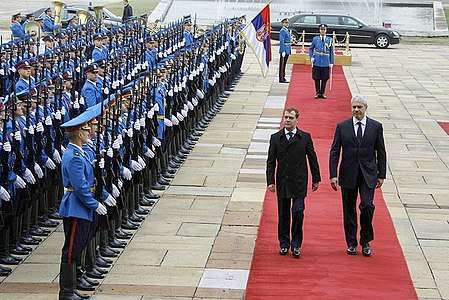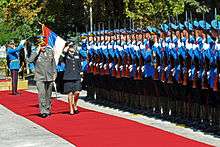Serbian Guards Unit
| Serbian Guard | |
|---|---|
|
Гарда Војске Србије Garda Vojske Srbije | |
 Serbian Guards in the 2015 Moscow Victory Day Parade. | |
| Active | 1830–present |
| Country |
|
| Allegiance |
|
| Type | Honor Guard |
| Size | 4 Battalions, 2 independent companies |
| Headquarters | Belgrade |
| Commanders | |
| Chief of Staff | Brigadier General Milomir Todorović |
| Guard Sergeant Major |
Warrant officer 1st class Lazar Mažić |
| Insignia | |
| Ceremonial Flag |
.gif) |
The Serbian Guard is an honor guard unit of the Serbian Armed Forces.
History
The Serbian Guard was formed in 1830 by the order of Prince Miloš Obrenović. It originated with 73 people selected for service in the Guard. On May 12, 1838, the Guard gained legal status from a special decree of Prince Milos. In 1883, the Guard was transformed into a Royal Guard. Royal Serbian Guard was considered as elite unit of the Royal Serbian Army and only the best conscripts were chosen to serve in it ranks. In 1914 the Royal Guard numbered a few thousand members and took part in all major battles of the Balkans Campaign (World War I). During the Second World War, the Guard was commanded by lieutenant-colonel Nikola Kalabić and was fighting against both Axis powers, their collaborators and communist partisans. On November 1, 1944, the members of the Royal Guard were absorbed into the Yugoslav People's Army. During the breakup of Yugoslavia in 1991, the Guards took part in the Battle of Vukovar and in the battles in Eastern Slavonia. It played an important role in these events, becoming strike force for the JNA. The Serbian Guard in its current form was formed on November 30, 2006.[1]
Structure
- Headquarters Company
- Command Battalion
- Honor Guard Battalion
- 25th Military Police Battalion
- Supply Battalion
- Special Purpose Company
- Independent Honor Guard Drill Company
- Guards Band
Gallery



.jpg)



.jpg) During the 2014 Belgrade Liberation Day Parade.
During the 2014 Belgrade Liberation Day Parade. The salute battalion.
The salute battalion.
Links
References
- ↑ sisteme, Vojska Srbije | Serbian Armed Forces :: Centar za komandno-informacione. "Војска Србије | Организација | Јединице Генералштаба Војске Србије | Гарда". www.vs.rs. Retrieved 2017-11-11.